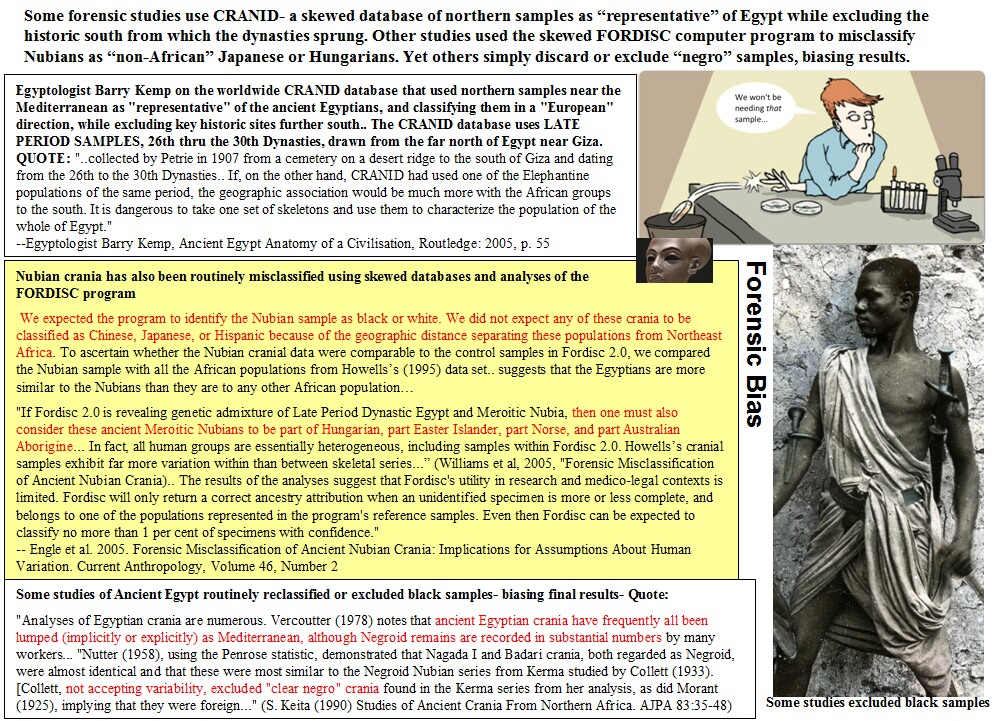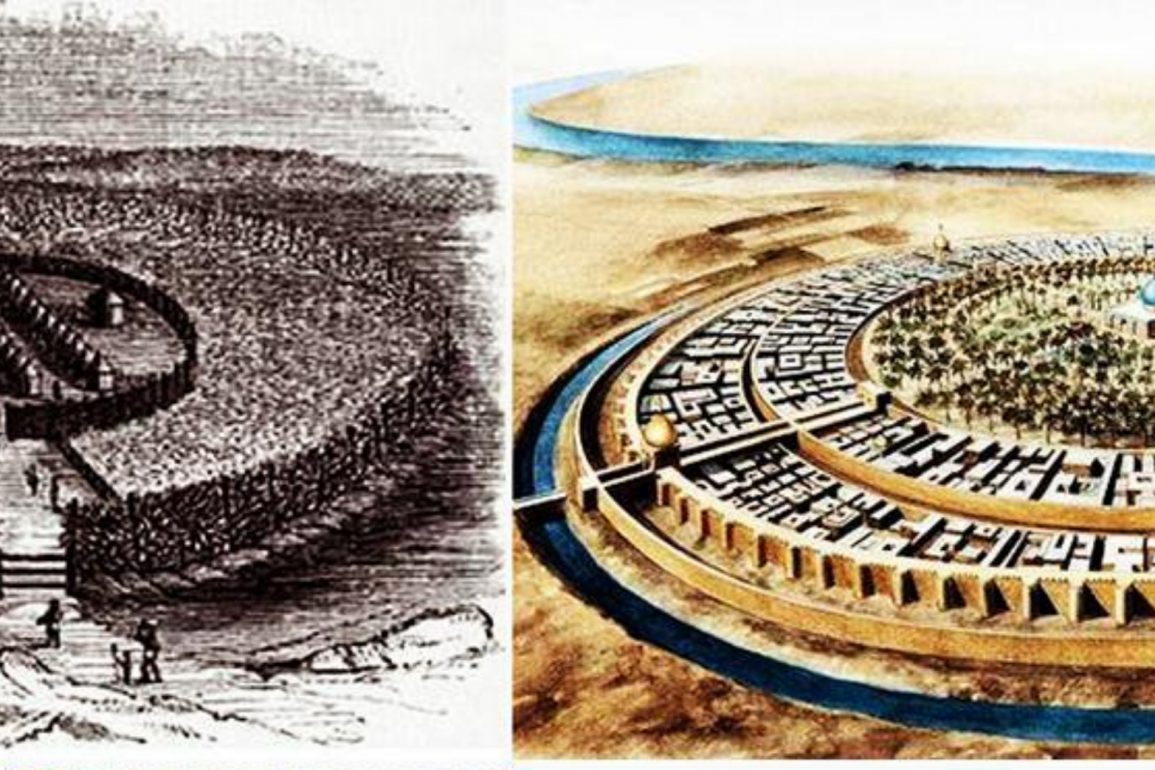Post by zarahan on Mar 4, 2023 11:16:04 GMT -5
Some anthropology and forensic studies have often distorted African data and samples
when in comes to Ancient Egypt per mainstream scholars reexamining the evidence

Exclusion or reclassification of African samples
"Analyses of Egyptian crania are
numerous. Vercoutter (1978) notes that
ancient Egyptian crania have frequently
all been lumped (implicitly or explicitly)
as Mediterranean, although Negroid
remains are recorded in substantial
numbers by many workers... "Nutter
(1958), using the Penrose statistic,
demonstrated that Nagada I and Badari
crania, both regarded as Negroid, were
almost identical and that these were most
similar to the Negroid Nubian series from
Kerma studied by Collett (1933).
[Collett, not accepting variability,
excluded "clear negro" crania found in
the Kerma series from her analysis, as did
Morant (1925), implying that they were
foreign..."
--(S. Keita (1990) Studies of
Ancient Crania From Northern Africa.
AMERICAN JOURNAL OF PHYSICAL ANTHROPOLOGY
83:35-48)
Skewed stereotypical forensic "racial" databases- CRANID
While the CRANID anthro reference database is skewed towards Northern Egypt
and downplays the tropical south (Kemp 2005), some forensic analyses of mummies
on the same skewed data still indicates membership in the "Egyptian" group-
with the next closest match being African.
--QUOTE:
"A mummy of an Egyptian priestess dating from the 22nd dynasty (c. 770 BC),
completely enclosed in an anthropoid (human shaped) coffin, was scanned
on a CT scanner. An accurate reconstruction of the cranium was generated
from 115 × 2 mm CT images using AVS/Express on a SGI computer. Linear
measurements were obtained from six orthogonal cranial views and used
in a morphometric analysis software package (CRANID). The analyses
carried out were both linear and nearest neighbour discriminant analysis.
The results show that there is a 52.9% probability that the mummy is an
Egyptian female, with a 24.5% probability that the mummy is an African female."
--Hughes, Wright, and Barry (2005)Virtual reconstruction and morphological
analysis of the cranium of an ancient Egyptian mummy. Australas. Phys. Eng. Sci. Med.
Vol. 28, No 2, 2005
------------------------------------------------
Egyptologist Barry Kemp on the
worldwide CRANID database that used
northern samples near the Mediterranean
as "representative" of the ancient
Egyptians, and classifying them in a
"European" direction, while excluding
key historic sites further south..
"If, on the other hand, CRANID had
used one of the Elephantine populations
of the same period, the geographic
association would be much more with the
African groups to the south."
(Barry Kemp, Ancient Egypt Anatomy of
a Civilisation, Routledge: 2005, p. 55)
Forensic misclassification of Africans 2- Nubians and FORDISC database
“If Fordisc 2.0 is revealing genetic admixture of Late Period
Dynastic Egypt and Meroitic Nubia, then one must also consider
these ancient Meroitic Nubians to be part of Hungarian, part Easter
Islander, part Norse, and part Australian Aborigine, with smaller
contributions from the Ainu, Teita, Zulu, Santa Cruz, Andaman Islands,
Arikara, Ayatal, and Hokkaido populations. In fact, all human groups
are essentially heterogeneous, including samples within Fordisc 2.0.
Using Fst heritability tests, Relethford (1994) demonstrated that Howells’s
cranial samples exhibit far more variation within than between skeletal
series. There is no reason to assume that the heterogeneity of the Late
Period Dynastic Egyptian population exceeds that characterizing our Nubian
sample. This heterogeneity may also characterize the populations in the
Forensic Data Bank; Fordisc 2.0 classified the Meroitic Nubians not
as either all black or all white but as black, white, Hispanic, Chinese,
Japanese, and Native American.” - Williams et al. 2005
Such is the result of preconceived attempts to force superficial population
variations to undeviating non-overlapping socio-ethnic or "racial" types."[/i]
Frank l'engle Williams, Robert L. Belcher, and George J . Armelagos,
"Forensic Misclassification of Ancient Nubian Crania: Implications for
Assumptions about Human Variation," Current Anthro. vol 46 (2005), pages 340-346

when in comes to Ancient Egypt per mainstream scholars reexamining the evidence

Exclusion or reclassification of African samples
"Analyses of Egyptian crania are
numerous. Vercoutter (1978) notes that
ancient Egyptian crania have frequently
all been lumped (implicitly or explicitly)
as Mediterranean, although Negroid
remains are recorded in substantial
numbers by many workers... "Nutter
(1958), using the Penrose statistic,
demonstrated that Nagada I and Badari
crania, both regarded as Negroid, were
almost identical and that these were most
similar to the Negroid Nubian series from
Kerma studied by Collett (1933).
[Collett, not accepting variability,
excluded "clear negro" crania found in
the Kerma series from her analysis, as did
Morant (1925), implying that they were
foreign..."
--(S. Keita (1990) Studies of
Ancient Crania From Northern Africa.
AMERICAN JOURNAL OF PHYSICAL ANTHROPOLOGY
83:35-48)
Skewed stereotypical forensic "racial" databases- CRANID
While the CRANID anthro reference database is skewed towards Northern Egypt
and downplays the tropical south (Kemp 2005), some forensic analyses of mummies
on the same skewed data still indicates membership in the "Egyptian" group-
with the next closest match being African.
--QUOTE:
"A mummy of an Egyptian priestess dating from the 22nd dynasty (c. 770 BC),
completely enclosed in an anthropoid (human shaped) coffin, was scanned
on a CT scanner. An accurate reconstruction of the cranium was generated
from 115 × 2 mm CT images using AVS/Express on a SGI computer. Linear
measurements were obtained from six orthogonal cranial views and used
in a morphometric analysis software package (CRANID). The analyses
carried out were both linear and nearest neighbour discriminant analysis.
The results show that there is a 52.9% probability that the mummy is an
Egyptian female, with a 24.5% probability that the mummy is an African female."
--Hughes, Wright, and Barry (2005)Virtual reconstruction and morphological
analysis of the cranium of an ancient Egyptian mummy. Australas. Phys. Eng. Sci. Med.
Vol. 28, No 2, 2005
------------------------------------------------
Egyptologist Barry Kemp on the
worldwide CRANID database that used
northern samples near the Mediterranean
as "representative" of the ancient
Egyptians, and classifying them in a
"European" direction, while excluding
key historic sites further south..
"If, on the other hand, CRANID had
used one of the Elephantine populations
of the same period, the geographic
association would be much more with the
African groups to the south."
(Barry Kemp, Ancient Egypt Anatomy of
a Civilisation, Routledge: 2005, p. 55)
Forensic misclassification of Africans 2- Nubians and FORDISC database
“If Fordisc 2.0 is revealing genetic admixture of Late Period
Dynastic Egypt and Meroitic Nubia, then one must also consider
these ancient Meroitic Nubians to be part of Hungarian, part Easter
Islander, part Norse, and part Australian Aborigine, with smaller
contributions from the Ainu, Teita, Zulu, Santa Cruz, Andaman Islands,
Arikara, Ayatal, and Hokkaido populations. In fact, all human groups
are essentially heterogeneous, including samples within Fordisc 2.0.
Using Fst heritability tests, Relethford (1994) demonstrated that Howells’s
cranial samples exhibit far more variation within than between skeletal
series. There is no reason to assume that the heterogeneity of the Late
Period Dynastic Egyptian population exceeds that characterizing our Nubian
sample. This heterogeneity may also characterize the populations in the
Forensic Data Bank; Fordisc 2.0 classified the Meroitic Nubians not
as either all black or all white but as black, white, Hispanic, Chinese,
Japanese, and Native American.” - Williams et al. 2005
Such is the result of preconceived attempts to force superficial population
variations to undeviating non-overlapping socio-ethnic or "racial" types."[/i]
Frank l'engle Williams, Robert L. Belcher, and George J . Armelagos,
"Forensic Misclassification of Ancient Nubian Crania: Implications for
Assumptions about Human Variation," Current Anthro. vol 46 (2005), pages 340-346




 The only thing I have to disagree with is, that's not the Benin Wall, I've seen this used plenty of times, but it's simply wrong, the wall is not circular it is gridiron, the wall above looks like it is made of a large shrub, another seemed to be lifted from the sea wall of Carthage.
The only thing I have to disagree with is, that's not the Benin Wall, I've seen this used plenty of times, but it's simply wrong, the wall is not circular it is gridiron, the wall above looks like it is made of a large shrub, another seemed to be lifted from the sea wall of Carthage. 


